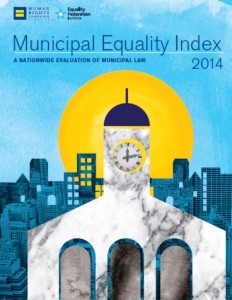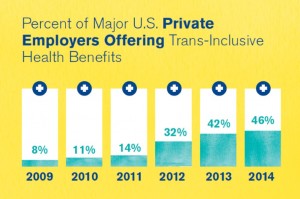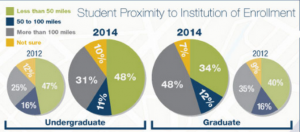Municipal Equality Index Finds CT Above Average for LGBT Residents
/Connecticut cities continue to rank above-average when compared with municipalities across the country in the level of equality provided to lesbian, gay, bisexual, and transgender (LGBT) residents. Bridgeport, Hartford, New Haven, Stamford and Storrs (Mansfield) were the five Connecticut municipalities included by the Human Rights Campaign (HRC), the nation’s largest LGBT civil rights organization, in an assessment of LGBT equality in 353 cities across the nation.

The 2014 Municipal Equality Index (MEI), the only nationwide rating system of LGBT inclusion in municipal law and policy, shows that cities across the country, including in Connecticut, continue to take the lead in supporting LGBT people and workers, even when states and the federal government have not.
The average score for the five municipalities in Connecticut was 74 out of 100 points, comfortably above the national average of 59. The individual scores in Connecticut, largely unchanged from a year ago, were New Haven: 100, Hartford: 92, Stamford: 62, Storrs (Mansfield): 59, and Bridgeport: 57. The scores earned by Hartford and Bridgeport dropped slightly from a year ago, and New Haven scored at 100 for the second consecutive year. Because of changes in the legal landscape from year to year, the MEI report has revised the scoring assessment criteria, which has impacted scores in some municipalities.
Cities are rated on a scale of 0-100, based on the city’s laws, policies, benefits, and services. Key findings contained in the 70-page MEI report, issued in partnership with the Equality Federation, provide “a revealing snapshot of LGBT equality in municipalities of varying sizes, and from every state in the nation,” the report noted.
with the Equality Federation, provide “a revealing snapshot of LGBT equality in municipalities of varying sizes, and from every state in the nation,” the report noted.
The MEI rates cities based on 47 criteria falling under six broad categories:
- Non-discrimination laws
- Relationship recognition
- Municipality’s employment policies, including transgender-inclusive insurance coverage, contracting non-discrimination requirements, and other policies relating to equal treatment of LGBT city employees
- Inclusiveness of city services
- Law enforcement
- Municipal leadership on matters of equality
The cities researched for the 2014 MEI include the 50 state capitals, the 200 most populous cities in the country, the four largest cities in every state, the city home to each state’s largest public university, and an equal mix of 75 of the nation’s large, mid-size and small municipalities with the highest proportion of same-sex couples.
The report found that “momentum for municipal equality is not a coastal trend or mega-urban phenomenon – it is something cities of all sizes in all parts of the country are doing because the people in those cities demand equality of treatment for all.” Cities had an opportunity to review the draft scorecard and offer feedback prior to publication.
Equality and Economic Development
The report also indicates that “a growing body of research has shown that cities that have vibrant gay and lesbian communities have higher levels of income, life satisfaction, housing values, and emotional attachment to their community as well as higher concentrations of high-tech business. The Fortune 500 has long recognized that top talent is attracted to inclusiveness. In fact, the private sector has been using fair workplaces as a tool to recruit and retain top talent.”
The report adds that “Businesses will increasingly have to evaluate the legal landscape offered by a potential new location in its calculation of where to expand operations.” Connecticut’s state laws – such as marriage equity and non-discrimination protections – provide a hospitable environment for its cities to employ equitable practices, officials said, but municipalities also have the capacity to take the lead, in Connecticut and elsewhere. In ten states, cities fare well despite restric tive state laws.
tive state laws.
“From Mississippi to Idaho, mid-size cities and small towns have become the single greatest engine of progress for LGBT equality--changing countless lives for the better,” said HRC President Chad Griffin. “In just three years, the number of municipalities earning top marks for their treatment of LGBT citizens has more than tripled. Simply put, in this country there is an ongoing race to the top to treat all people, including LGBT people, fairly under the law, and it’s time our state and federal laws caught up.”
According to the report, the New England, Mid-Atlantic, and Western regions of the United States – where marriage equality states have predominated – tend to do better than the national average when it comes to municipal equality. The reported pointed out, however, that every region has at least one 100-point city, such as New Haven. For example, in the Southeast, Florida boasts three 100-point scores, and Atlanta repeats its perfect score again in 2014; in the Southwest, Austin repeats its perfect score; and in the Plains, Iowa City joins two perfect scores in Missouri with St. Louis and Kansas City.
Thirty-eight cities earned perfect 100-point scores, up from 25 in 2013 and 11 in 2012, the first year of the MEI. New Haven earned a 100-point score, helping to set a standard of LGBT inclusiveness with exemplary policies ranging from non-discrimination laws and equal employee benefits, to cutting edge city services.
Among the report’s striking findings: A dramatic increase in the number of cities offering transgender-inclusive healthcare benefits, and the fact that 32 million people have better protections from discrimination on the basis of gender identity at the local level then they do from state law. The full report is available online at www.hrc.org/mei.





 This past Saturday, the Huskies football team played Army at Yankee Stadium – the
This past Saturday, the Huskies football team played Army at Yankee Stadium – the 




 aring workers for higher-level jobs is not quite as strong, the majority of respondents nonetheless believe Connecticut schools and colleges provide an adequate education for mid-level employees (59% of employers surveyed); management workers (61% of employers); and executive-level employees (58%).
aring workers for higher-level jobs is not quite as strong, the majority of respondents nonetheless believe Connecticut schools and colleges provide an adequate education for mid-level employees (59% of employers surveyed); management workers (61% of employers); and executive-level employees (58%).

 epartment of State. He also writes foreign policy columns for the Boston Globe and Global Post and is a noted lecturer on U.S. foreign policy.
epartment of State. He also writes foreign policy columns for the Boston Globe and Global Post and is a noted lecturer on U.S. foreign policy. nt George H.W. Bush to the National Security Council, a post he held until 1995, bridging the administrations of Bush and President Bill Clinton.
nt George H.W. Bush to the National Security Council, a post he held until 1995, bridging the administrations of Bush and President Bill Clinton.

 “There was another exchange about the recent release of Mrs. Belaga's joint tax return, which showed that she and her husband, Myron, paid $110 in Federal income taxes last year because of losses incurred by an investment business being started by her husband. The couple reported total assets of $1.4 million.
“There was another exchange about the recent release of Mrs. Belaga's joint tax return, which showed that she and her husband, Myron, paid $110 in Federal income taxes last year because of losses incurred by an investment business being started by her husband. The couple reported total assets of $1.4 million.


























